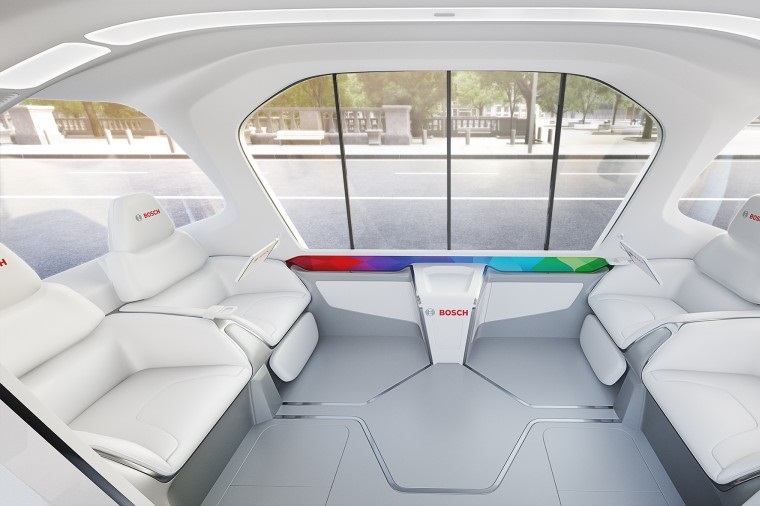In 2019, the new car market is divided into several segments: Sedans, SUVs, minivans, pickup trucks, and so on. German components manufacturer Bosch envisions the creation of a new segment as soon as autonomous technology merges into the mainstream. It predicts that driverless electric shuttles will become a common sight in major cities all around the world, and it traveled to CES to showcase how it plans to be a part of this nascent segment.
The firm stresses that it built its design study concept vehicle purely to showcase what’s inside of it; it has no plans to become an automaker. It’s leaving that part to established car companies, like Volvo. The concept is shaped like a box to maximize interior space, and it’s fitted with huge side windows to give the passengers an unobstructed view of the outside world. It offers space for four passengers in this configuration, though other layouts are certainly possible.
The infotainment screens can be used individually or shared by two or more riders if they want to enjoy the same content. For example, one passenger can look at the trip progress, two can stream a movie from a smartphone via the onboard Wi-Fi connection, and the fourth can fold the screen out of the way to read a book. The infotainment system also provides information (including the weather and restaurant recommendations) about the destination, a feature that looks ahead to when driverless shuttles embark on longer trips, not just on short hops across a city.
Camera technology has gotten precise enough that it can identify a piece of gum on the seat or a spilled cup of coffee.
Camera-based sensors check the cabin to make sure passengers didn’t leave belongings, and it automatically pings them if it detects a forgotten object. It also knows whether the shuttle needs cleaning; camera technology has gotten precise enough that it can identify a piece of gum on the seat or a spilled cup of coffee. Of course, it’s better for everyone if riders leave the shuttle in the same condition they found it in.
We’ve gotten ahead of ourselves; Bosch plans to enter the shuttle-sharing economy at the booking stage, before users have a chance to spill their caramel macchiato. It’s developing a software platform that connects users to shuttles via a smartphone application, finds the best way from point A to point B, and checks if anyone else needs a ride along the way — assuming the person requests the ride wants to carpool, of course. And since there’s no human driver, digital access technology lets the shuttle identify the passenger who requested the ride via his or her
Bosch-built technology also helps the shuttle move. It’s powered by the firm’s electric drive axles, and it relies on software designed in-house to tell how much range is left in the battery, how much electrical equipment like the A/C uses, and whether the shuttle has enough battery power left to take its passengers to their destination. Shuttles running low will be automatically taken out of service and directed to the nearest charging station.
Radars, ultrasonic sensors, braking control systems, and power steering components are all made by the firm, and the map-based localization software that tells the shuttle precisely where it is comes from Bosch, too. It’s a massive investment, but the company’s executives believe it will pay off in the not-too-distant future. Right now, autonomous shuttles are few and far between. Bosch predicts that, in 2020, there will be about a million of them on the road in Europe, the United States, and China. That number will grow to 2.5 million by 2025. There are still several hurdles to clear before shuttles become mainstream, though.
“There will not be an autonomous world without having a working V2X solution,” Bernd Heinrichs, the executive vice president and chief digital officer of Bosch’s smart mobility solution, told Digital Trends during CES. He added 5G and similar technologies are essential as well.















